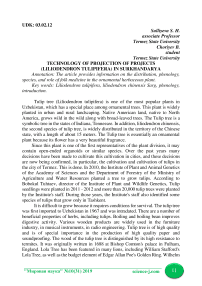Technology of projection of projects (Liliodendron tulipifera) in Surkhandarya
Автор: Sulliyeva S.H., Choriyev B.
Журнал: Мировая наука @science-j
Рубрика: Основной раздел
Статья в выпуске: 10 (31), 2019 года.
Бесплатный доступ
The article provides information on the distribution, phenology, species, and role of folk medicine in the ornamental herbaceous plant.
Liliodendron tulipifera, liliodendron chinensis sarg, phenology, intraduction
Короткий адрес: https://sciup.org/140263929
IDR: 140263929 | УДК: 03.02.12
Текст научной статьи Technology of projection of projects (Liliodendron tulipifera) in Surkhandarya
Tulip tree (Liliodendron tulipifera) is one of the most popular plants in Uzbekistan, which has a special place among ornamental trees. This plant is widely planted in urban and rural landscaping. Native American land, native to North America, grows wild in the wild along with broad-leaved trees. The Tulip tree is a symbolic tree in the states of Indiana, Tennessee. In addition, liliodendron chinensis, the second species of tulip tree, is widely distributed in the territory of the Chinese state, with a length of about 15 meters. The Tulip tree is essentially an ornamental plant because its flower has a very beautiful fragrance.
Since this plant is one of the first representatives of the plant division, it may contain open-ended organoids or similar species. Over the past years many decisions have been made to cultivate this cultivation in cities, and these decisions are now being confirmed, in particular, the cultivation and cultivation of tulips in the city of Termez. This is done. In 2010, the Institute of Plant and Animal Genetics of the Academy of Sciences and the Department of Forestry of the Ministry of Agriculture and Water Resources planted a tree to grow tulips. According to Bobokul Tuhtaev, director of the Institute of Plant and Wildlife Genetics, Tulip seedlings were planted in 2011 - 2012 and more than 20,000 tulip trees were planted by the Institute's staff. During those years, the Institute's staff also identified some species of tulips that grow only in Tashkent.
It is difficult to grow because it requires conditions for survival. The tulip tree was first imported to Uzbekistan in 1967 and was intradated. There are a number of beneficial properties of herbs, including tulips. Boiling and boiling bean improves digestive activity. Various wooden products are widely used in the furniture industry, in musical instruments, in radio engineering. Tulip tree is of high quality and is of special importance in the production of high quality paper and soundproofing. The wood of the tulip tree is distinguished by its high resistance to termites. It was originally written in 1688 at Bishop Comton's palace in Fulham, England. Lola Tree has been featured in many lions, including William Stafford's Lola Tree, as well as the budget element of Edgar Allan Poe's Golden Ring. Wilhelm
Shimmel and Shields Landon, the legendary sculptors of their time, were one of the favorite tree species for wood carving.
The most common species on the Earth are the North American Tulip tree, which is popular in the world as an ornamental tree. The North American tulip tree (liliodendron tulipifera) has its own unique landscape in broad-leaved forests. The second type of Liliodendron is the Chinese liliodendron or the Chinese tulip tree (Liliodendron chinensis Sarg). This species of liliodendron grows wild in the Kiangxi Province of China and resembles a tulip tree with the flower and leaf structure. The Chinese use wood as a decoration material. Tulip trees come to us from far distances, which is why it is now expensive.
Reproduction of tulips is very difficult because 90% of the seeds are devoid of seeds. So how can we grow this plant under our circumstances? What are the methods of growing this tree in Surkhandarya? In Uzbekistan, tulips will blossom in May and will ripen in late September. It is considered to be a lush vegetation and is more resistant to drought and heat. Another feature of the tulip tree is that it is very resistant to dust mold, which makes it suitable for growing in Surkhandarya. As a result of the study of the plant phenology, the following data were revealed, including the low temperature of the Surkhandarya region. and should be protected against high heat. To protect against heat, it is advisable to use poles and other poles. If their seeds are sown in the spring, they will germinate in the spring, and if sown in the spring, they can usually remain in the soil for one year. In the early spring planting can withstand temperatures of 25 - 30 ° C. The soil in which the seed is sown should be sufficiently moist. In germination, the seeds must be stratified before sowing. Flowers resemble two-tailed tulip flower - yellowish-yellowish -white, pollinated by insects that reach 5 to 6 cm in size. Leaves with simple long leaves, with 4 to 6 leaves, ranging in length from 7 to 15 cm. The stem is smooth and shiny. In the autumn, the stems and leaves turn yellow and give a beautiful look. The Tulip tree is also known for its rapid growth and longevity. In the homeland, the stem grows flat and reaches 60 M in diameter and 3.5 M in length. The young branches are brownish gray and leave white hair at the age of two. Its fruit is dome and ripens in autumn. The dome's fruit consists of wing-shaped parts and places the seed within each wing. In the fall, the dome ripens and the wings are scattered around by the wind. Seed survival is between 5 and 7 years.
In recent years, tulips have been planted in many cities of Uzbekistan in Tashkent, Ferghana, Margilan, Namangan, Andijan, Samarkand, Termez, and Karshi.
Expanding the technology of cultivation of tulips in Surkhandarya will enable us to create new varieties that will benefit not only the region, but also the economy of the country, as there is a great potential for selling tulips.

Список литературы Technology of projection of projects (Liliodendron tulipifera) in Surkhandarya
- AK Kayumov, E.T. Berdiyev, H.F. Khamroyev, S.A. Turdiyev. "Dendrology" Tashkent 2015 "Science and Technology" 360 pages
- AA Matkarimova, T.Kh. Mahkamov, M.M. Makhmudova, H.Ya. Azizov, G.b. Vaisova "Botany" Tashkent 2018 Science and Technology 300 pages
- The letter "L" "National Encyclopedia of Plants". State Scientific Publishing House. Tashkent.
- O. Pratov, L. Shamsuvaliyeva, E. Sulaymanov, X. Akhunov, K. Ibodov, V. Mahmudov. "Botany" (Morphology, Anatomy, Systematics, Geobotany) "Education Publishing House" Tashkent 2010


